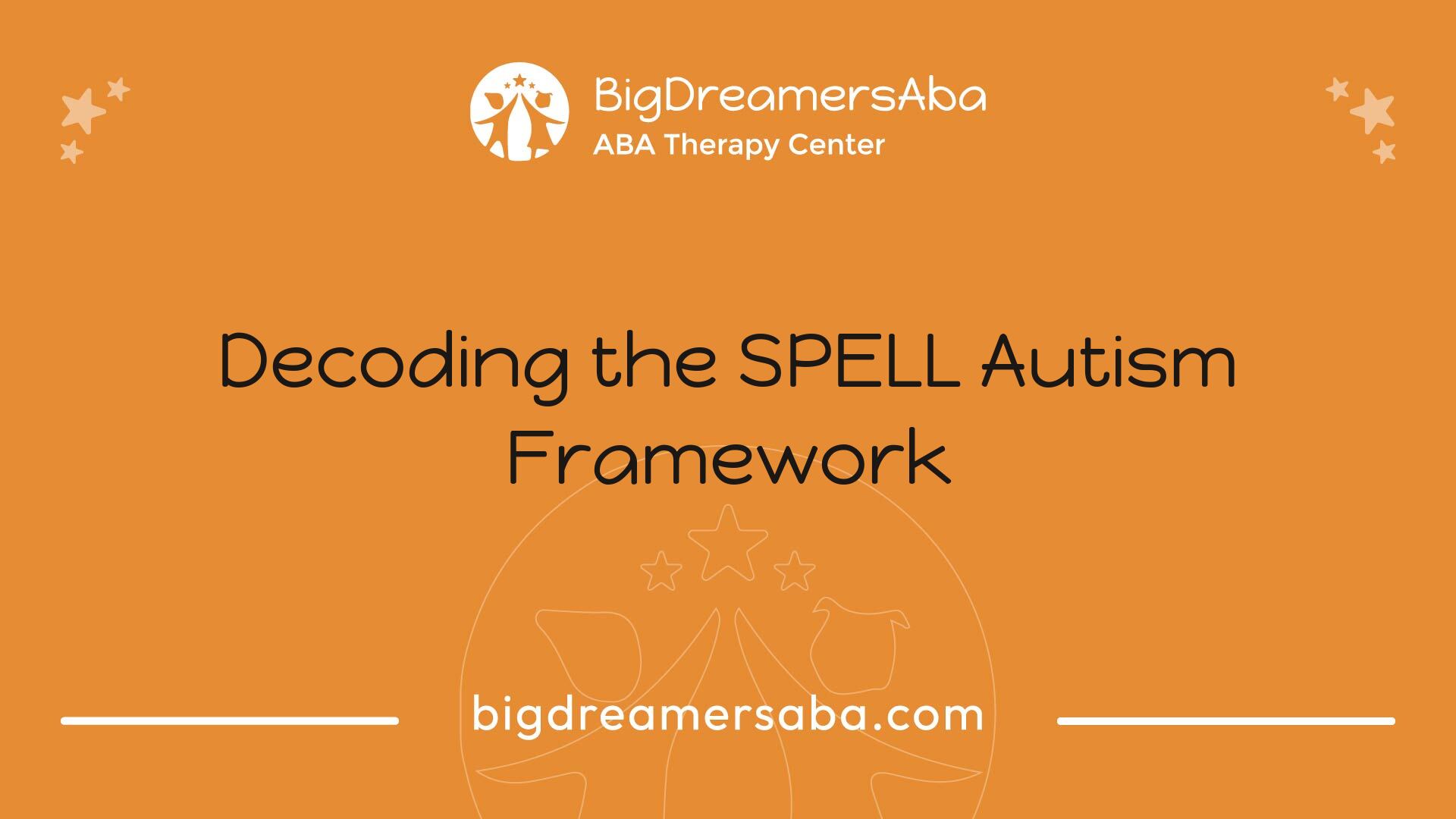Decoding the SPELL Autism Framework
Explore the SPELL autism framework to enhance communication, promote independence, and support individuals effectively.


Understanding SPELL Framework
The SPELL autism framework offers a comprehensive approach to understanding and responding to the needs of autistic individuals. This framework is vital for supporting both children and adults on the autism spectrum.
Components of SPELL Framework
The SPELL acronym stands for Structure, Positive approaches, Empathy, Low arousal, and Links. Each of these components plays a critical role in creating effective support strategies for autistic individuals:
ComponentDescriptionStructureProvides a predictable and organized environment, enhancing personal autonomy and reducing anxiety.PositiveFocuses on building self-confidence and reinforcing the individual’s strengths, interests, and abilities.EmpathyInvolves understanding the experiences of autistic individuals by seeing the world from their perspective.Low ArousalAims to create calm and peaceful environments, minimizing stress and sensory overload.LinksEncourages connections with others and the community, promoting social relationships and support networks.
The SPELL framework emphasizes that interventions and planning must be customized based on the unique needs of each autistic individual, regardless of their age or level of support required.
Importance of Positive Approaches
The Positive element of the SPELL framework is crucial as it aims to enhance the self-esteem and self-confidence of autistic individuals. The focus on recognizing and building upon natural strengths, interests, and capabilities encourages a supportive environment. High and realistic expectations, guided by careful assessments of individual skills, lead to more effective support [1].
Creating a positive atmosphere helps in fostering motivation and encourages autistic individuals to thrive. This approach not only nurtures their potential but also reinforces their ability to navigate the world around them confidently. By prioritizing positivity, supporters can contribute to a more fulfilling and empowered experience for those on the autism spectrum.
Understanding the SPELL autism framework and its components allows caregivers, educators, and supporters to implement strategies that genuinely resonate with the needs of autistic individuals, ultimately creating a more inclusive and empathetic environment.
Implementing SPELL Framework

The SPELL Autism Framework offers a structured approach for supporting individuals with autism spectrum disorder (ASD). This section explores the benefits of the low arousal principle and shares success stories related to implementing the framework.
Benefits of Low Arousal Principle
The low arousal principle of the SPELL Framework aims to create a supportive environment that minimizes distractions, promotes learning, enhances communication, and improves overall well-being for individuals with autism. By maintaining calm and predictable settings, this principle reduces anxiety and helps manage challenging behaviors [2].
Some specific benefits of the low arousal principle include:
BenefitDescriptionReduced AnxietyCreates a safe atmosphere, lowering stress levels for individuals with ASD.Enhanced FocusMinimizes distractions, allowing for better concentration and engagement in activities.Improved CommunicationFosters an environment conducive to social interaction and effective communication.Supportive LearningAdaptable settings help individuals to learn and grow at their own pace.
The SPELL Framework, developed by the National Autistic Society in the UK, is recognized globally for its effectiveness in supporting individuals with autism [3].
Success Stories and Outcomes
Implementing the SPELL Framework has led to various positive outcomes in different settings, including schools and therapy programs. For instance, many educators have reported significant improvements in students' communication and social skills, as well as their ability to work independently.
Some notable successes include:
The SPELL Framework emphasizes structure, positive reinforcement, empathy, low-arousal environments, and creating meaningful connections. These components have transformed the experiences of many individuals with ASD, allowing them to thrive in various aspects of life [2].
For additional insights into autism support, consider exploring topics such as accommodations for students with autism or what is social skills training (SST) for autism?.
Impact of SPELL Framework

The SPELL Autism Framework has a substantial impact on individuals with autism, particularly in enhancing communication skills and promoting independence and autonomy. This model integrates structured support, positive reinforcement, empathy, low-arousal environments, and linked communication.
Enhancing Communication Skills
Implementing the SPELL framework significantly enhances the communication abilities of individuals with autism. The framework focuses on creating structured environments that foster effective communication patterns. By establishing clear expectations and routines, individuals are more likely to engage in social interactions, reducing anxiety and improving social skills.
Research highlights that the principles of the SPELL framework—especially positive reinforcement and empathy—support the development of essential communication skills. For example, using visual supports or simplified language can aid in making communication more accessible and understandable. Additionally, adapting individual strategies through observations and assessments allows for tailored approaches that cater to each person's unique communication needs [3].
Here is a summary of key communication improvements associated with the FRAMEWORK:
Communication SkillOutcomeSocial InteractionImproved frequency and qualityUnderstanding of InstructionsGreater clarity and adherenceExpressing NeedsEnhanced ability to communicate desires and feelings
Promoting Independence and Autonomy
The SPELL Autism Framework also plays a crucial role in promoting independence and autonomy among individuals with autism. By emphasizing structure and providing a low-arousal environment, individuals can engage in activities that foster self-confidence and decision-making skills.
Evidence suggests that when individuals are supported through the principles of the SPELL framework, such as creating links and utilizing positive approaches, they experience a greater sense of autonomy. This empowerment allows them to take ownership of their choices and actions, leading to improved life satisfaction.
Here are some outcomes observed with the effective application of the SPELL framework:
Autonomy AspectOutcomeDaily Living SkillsIncreased ability to perform tasks independentlyDecision MakingEnhanced capability to make personal choicesSelf-AdvocacyGreater confidence in expressing personal needs
The SPELL Autism Framework encourages not only skill development but also a supportive approach that enhances the overall quality of life for individuals with autism. Through ongoing support and tailored strategies, individuals can thrive both socially and independently.
Tailoring SPELL Support
Implementing the SPELL Autism Framework involves customizing support to meet the unique needs of individuals with autism. Through individualized strategies and supportive environments, caregivers and educators can foster development and independence for those on the spectrum.
Individualized Strategies
The SPELL Autism Framework emphasizes the need for tailored strategies that address specific strengths, challenges, and preferences of each individual with autism. By utilizing thorough observations, interviews, and assessments, practitioners can customize their approach to better support each unique individual with Autism Spectrum Disorder (ASD) [3].
Key components of individualized strategies include:
StrategyDescriptionPersonalized Learning PlansDevelop plans based on each individual's learning style and preferences.Strength-Based ApproachFocus on leveraging strengths to build confidence and reduce anxiety.Flexible TechniquesAdopt varied methods to maintain engagement based on the individual’s responsiveness.Positive ReinforcementImplement reward systems that promote desired behaviors and communication.
Implementing the SPELL Framework has shown benefits such as enhancing communication and social skills, promoting independence, and reducing anxiety and challenging behaviors [2].
Creating Supportive Environments
Creating an inclusive and supportive environment is crucial for the successful implementation of the SPELL Framework. This involves establishing structured settings that encourage positive interactions and reduce anxiety.
Key aspects of supportive environments include:
Environment ElementDescriptionStructureProvide clear routines and expectations to help individuals feel secure.Low-Arousal SettingsCreate calm, quiet spaces to minimize sensory overload [2].Empathetic EngagementFoster understanding of the individual's perspective to facilitate communication.Open CommunicationEstablish strong partnerships with families and professionals to keep all parties informed and engaged.
Research indicates that implementing the SPELL framework, which includes these elements, can lead to improved social communication skills, reduced problem behaviors, and a better quality of life for individuals with ASD [3].
By focusing on individualized strategies and supportive environments, the SPELL Autism Framework can effectively empower individuals with autism to thrive. For more information on accommodations for students with autism, consider visiting our article on accommodations for students with autism.
Research on SPELL Framework
Understanding the research surrounding the SPELL Autism Framework includes exploring methodologies like Positive Behavioral Interventions and Supports (PBIS) and technology-assisted interventions.
Positive Behavioral Interventions and Supports
The Positive Behavioral Interventions and Supports (PBIS) initiative emerged from discussions in the 1980s regarding the use of aversive techniques to address challenging behaviors in individuals with autism. PBIS focuses on proactive and preventative strategies, emphasizing the importance of teaching alternative and adaptive behaviors NCBI. This approach relies on data-driven decision-making to effectively support individuals experiencing challenging behaviors.
Key Features of PBISDescriptionProactive StrategiesEmphasizes preventing challenging behaviors before they occurTeaching Alternative BehaviorsEncourages the learning of positive behaviors over negative onesData-Driven DecisionsUtilizes data to inform strategies and measure effectiveness
The effectiveness of PBIS aligns with the overarching goals of the SPELL framework, promoting positive experiences and healthy communication for individuals with autism. This enhances the individual’s overall well-being and facilitates better interactions.
Technology-Assisted Interventions
Technology-assisted interventions have seen significant growth over the last 40 years, largely due to advancements in technology such as tablets, smartphones, artificial intelligence, and virtual reality NCBI. These innovations provide various applications tailored to the educational needs of children and youth with autism.
Some popular technology-assisted interventions include:
Type of InterventionExamplesPersonalized Visual SchedulesHelps individuals plan their day visuallyVideo-ModelingDemonstrates behaviors or skills through video presentationsRemote TeachingFacilitates learning from a distance, especially useful during disruptions
The integration of these technologies not only supports engagement and interaction but also complements the principles of the SPELL framework, enhancing communication skills and personalizing educational experiences for individuals on the autism spectrum. For more information about strategies to support individuals with autism, visit our article on accommodations for students with autism.
Evolution of Autism Support
The landscape of support for individuals with autism has changed significantly over the years. This evolution can be observed through the increase in special education services and the adoption of evidence-based intervention practices.
Increase in Special Education Services
The growth in special education services for children with autism has been remarkable. In 1993, only 18,903 school-aged children and youth with autism in the United States received special education services. By 2018, this number had surged to 663,098, highlighting a significant increase in support available to children with autism over a 25-year period.
YearNumber of School-aged Children with Autism Receiving Services199318,9032000Data not specified2018663,098
This increase can be attributed to growing awareness about autism and the rights of individuals with disabilities, as well as legislative measures aimed at expanding access to special education services.
Evidence-Based Intervention Practices
By the year 2000, substantial knowledge had been accumulated regarding effective instructional and intervention practices for children with autism. This body of knowledge led to the identification of empirically-based intervention approaches focusing on critical developmental areas and the necessity of intervention intensity—specifically, the provision of services for at least 25 hours per week [4].
Implementing evidence-based practices became a primary theme in current intervention practices in education. These practices have been shown to enhance educational outcomes and support the overall development of children with autism.
The adoption of the SPELL autism framework aligns with these evidence-based practices, promoting a structured approach to intervention that is adaptable to individual needs. As research continues to evolve, understanding and implementing evidence-based strategies will remain essential in providing effective support for individuals on the spectrum.
Awareness of conditions related to autism, such as autism vs. Aspergers and support for families, including accommodations for students with autism, are critical components of this comprehensive evolution in autism support.
References
[2]:
[3]:
[4]:
Recent articles

How Long Does Autism Regression Last? Key Factors That Affect Progress

Why Does My Child Love Tickling So Much — Is It Autism?
.jpg)